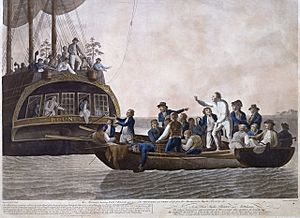Mutiny facts for kids

A mutiny happens when a group of people openly go against or try to remove someone in charge. It often means a group of soldiers trying to remove their officers. It can also be a group of sailors on a ship trying to remove the captain. The people who mutiny are called mutineers.
During the Age of Discovery, a mutiny was a serious rebellion against a ship’s captain. For example, during Magellan’s famous journey, some sailors mutinied. One mutineer was killed, another was given a very serious punishment, and two others were left on land. Later, after a mutiny on Henry Hudson’s ship Discovery, Hudson and several others were left in a small boat in the ocean.
Contents
What Happens to Mutineers?
Mutiny is still seen as a very serious crime. People who mutiny are severely punished. In some cases, they might even face the most extreme legal consequences.
Famous Mutinies in History
Mutinies in the 17th Century
- The Batavia was a ship from the Dutch East India Company. It was built in 1628 and crashed on its first trip. After the crash, some sailors started a mutiny and harmed many of the passengers.
- The Corkbush Field mutiny happened in 1647. Other mutinies like the Bishopsgate and Banbury mutinies happened in 1649. These events took place during the early part of the Second English Civil War.
Mutinies in the 18th Century

- HMS Hermione was a 32-gun frigate (a type of warship) of the British Royal Navy. It was built in 1782. This ship is famous because of a mutiny where the captain and eight officers were killed by the crew.
- The Mutiny on the Bounty happened on a British Royal Navy ship in 1789. This event has become very well-known through many books and films.
- The Spithead and Nore mutinies were two large mutinies by sailors of the British Royal Navy in 1797. The sailors wanted better pay and improved living conditions.
Mutinies in the 19th Century
- The Indian rebellion of 1857 was a big uprising in India against British rule. In Britain, it was often called the Indian Mutiny.
- The ship Sharon, a New England whaler, faced many mutinies. Many sailors left the ship. Eventually, the captain was killed by four crew members.
- The ship Somers, built in 1842, had a mutiny on its very first trip. The three mutineers faced severe consequences.
Mutinies in the 20th Century
- On the Russian battleship Potemkin, the crew rebelled against their officers in June 1905. This was part of the Russian Revolution of 1905. A famous film called The Battleship Potemkin was made about it.
 Russian Empire
Russian Empire - The Curragh Incident happened on July 20, 1914, in Curragh, Ireland. British soldiers protested against the Home Rule Act 1914.
 United Kingdom
United Kingdom - French Army mutinies took place in 1917. After the failure of the Nivelle Offensive in April and May 1917, many parts of the French Army mutinied. About 50 soldiers faced severe punishment, and more than 500 were sent to prison.
 France
France - The Wilhelmshaven mutiny began in the German High Seas Fleet on October 29, 1918. This mutiny was one of the events that helped bring an end to the First World War. It also led to the end of the monarchy and the start of the Weimar Republic.
 German Empire
German Empire - The Black Sea mutiny (1919) involved sailors on French dreadnoughts (large battleships) like Jean Bart and France. These ships were sent to help the White Russians in the Russian Civil War. The leaders of the mutiny, including André Marty and Charles Tillon, received long prison sentences.
 France
France - The Kronstadt rebellion was an unsuccessful rebellion by Soviet sailors. It was led by Stepan Petrichenko against the government of the early Russian SFSR in March 1921. It was the last major rebellion against Bolshevik rule.
- The Invergordon Mutiny was a Strike action (when people stop work) by about 1000 sailors in the British Atlantic Fleet. It happened on September 15-16, 1931. For two days, the sailors at Invergordon were in mutiny. This was one of the few military strikes in British history.
 United Kingdom
United Kingdom - The Cocos Islands Mutiny was a failed mutiny by Sri Lankan soldiers on the then-British Cocos (Keeling) Islands during the Second World War.
 United Kingdom
United Kingdom - The Port Chicago mutiny happened on August 9, 1944. This was three weeks after the Port Chicago disaster, where 320 sailors were killed and 390 injured in an explosion. Out of 320 African-American sailors in the Navy's supply part, 258 refused to load any ammunition. They believed it was not safe.
 United States
United States - The Sonderborg Denmark mutiny occurred on May 4, 1945. German sailors took over the German minesweeper M612. The next day, they were arrested, and 11 faced severe consequences.
 Nazi Germany
Nazi Germany
Mutinies After World War II
- The Post-World War II demobilization strikes happened in the Allied military forces. These forces were stationed across the Middle East, India, and Southeast Asia in the months and years after World War II.
- The Royal Indian Navy Mutiny was a complete strike and mutiny by Indian sailors of the Royal Indian Navy. It took place on ships and on shore at Bombay (Mumbai) harbour on February 18, 1946.
- The SS Columbia Eagle incident happened on March 14, 1970, during the Vietnam War. Sailors on an American merchant ship mutinied and took the ship to Cambodia.
- The Storozhevoy Mutiny occurred on November 9, 1975, in Riga, Latvia. The political officer locked up the Soviet Navy captain and sailed the ship toward Leningrad.
- The Velos mutiny happened on May 23, 1973. The captain of HNS Velos refused to go back to Greece after a NATO exercise.
|
See also
 In Spanish: Motín para niños
In Spanish: Motín para niños

